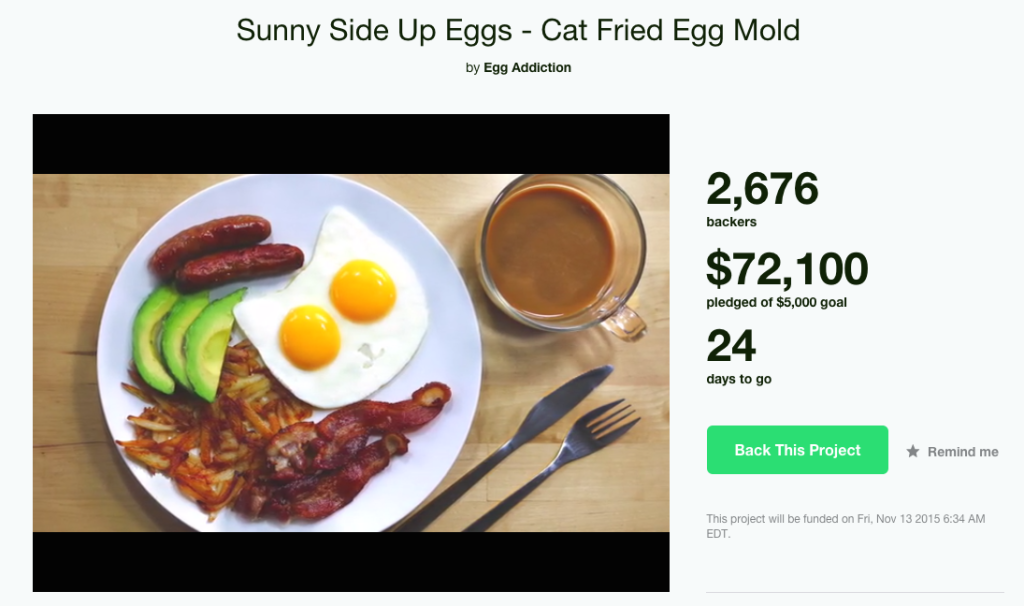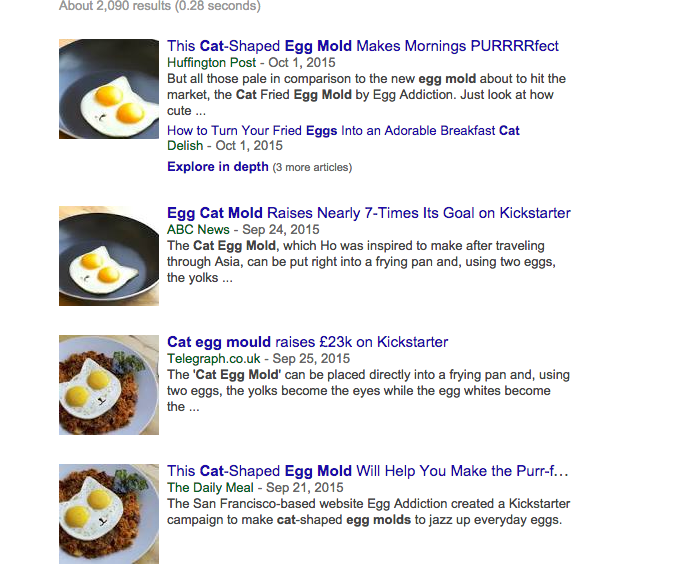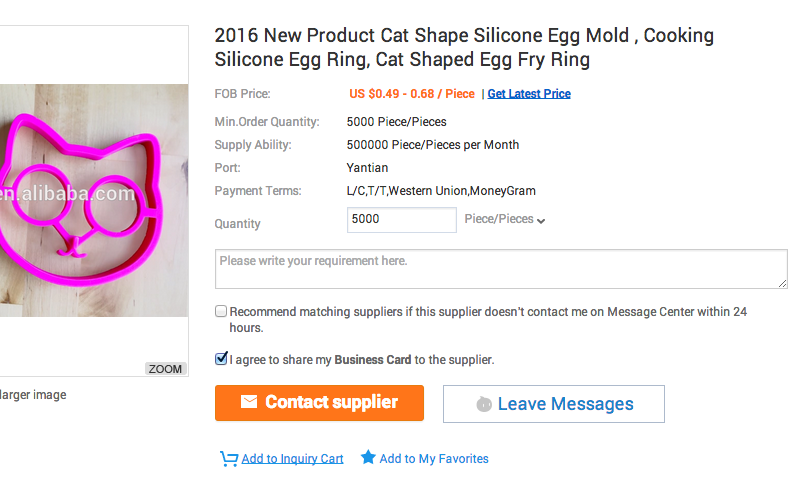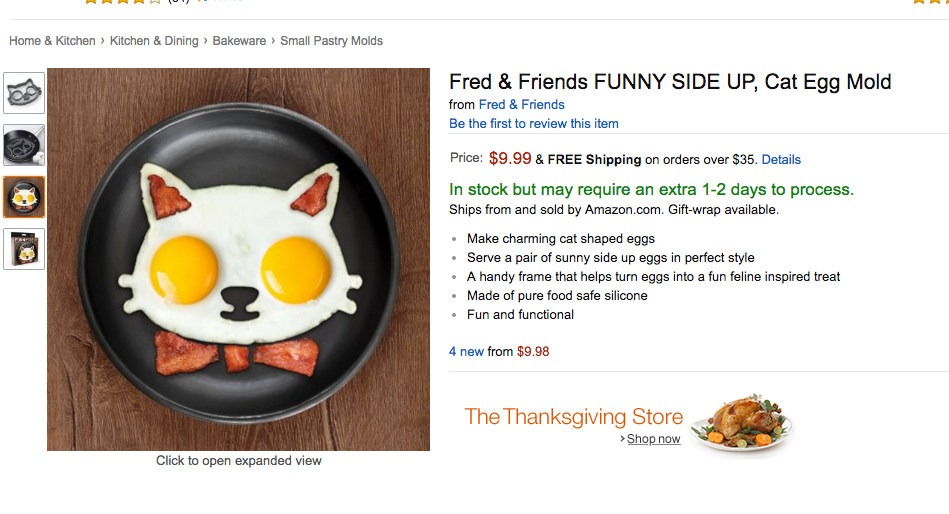You Don’t Need To Wait Until February To Get Your Cute Kitty Egg Mold
 A few weeks ago, a news story circulated about a cute and successful Kickstarter funding campaign. The story behind the product was simple: a woman who likes to cook eggs traveled through Asia, where adorable food molds are popular. She came home and designed a cat-shaped mold for cooking fried eggs, and the Internet threw money at her: more than $72,000 as of this writing. The end? No, not quite.
A few weeks ago, a news story circulated about a cute and successful Kickstarter funding campaign. The story behind the product was simple: a woman who likes to cook eggs traveled through Asia, where adorable food molds are popular. She came home and designed a cat-shaped mold for cooking fried eggs, and the Internet threw money at her: more than $72,000 as of this writing. The end? No, not quite.
Apparently, the kitty egg mold’s time has come. Sometimes different people have the same idea at the same time. In the mid-19th century, two men working separately, Charles Darwin and Alfred Russel Wallace came up with the theory of evolution. Last century, different teams of researchers all produced polio vaccines around the same time. And in the summer of 2015, at least three different people designed silicone food molds shaped like cats.
Those aren’t equally important accomplishments, but what they have in common is that the world was ready for them. Apparently, it’s the same with cat egg molds. This first came to our attention with the Kickstarter campaign from Egg Addiction.
The idea struck a chord with bloggers and writers all over, since it combined food, cats, and the opportunity to use the word “PURRRR-fect” in a headline. Apparently, though, none of those bloggers apparently bothered to type the words “cat egg mold” into their search engine of choice. That’s because similar products were already on the market in the United States, something that the articles failed to mention.

This is where things get complicated: people accused the campaign’s creator of simply buying egg molds on wholesale site Alibaba and passing them off as her own creation. Not so, the creator says: these sellers are stealing her photos and pretending to sell her design.

However, the Egg Addiction version isn’t the only yolk-eyed kitty on the market. You can find similar items at Sur La Table and Amazon, from popular novelty-item companies Gamago and Fred [Flare] & Friends.


Yet creator Cindy Ho, selling the egg molds under her blog brand of Egg Addiction, says that the different entities all seemed to come up with the same idea around the same time.
“While traveling throughout Asia, I was inspired by the food culture in Taiwan and Japan,” she told Consumerist. “I noticed that fun shaped animal goods get people really excited and happy.” She says that she brought the idea home with her and began creating prototypes, without any idea that other companies were developing their own kitteggs.
“During the time that I started designing and prototyping, there were absolutely no cat egg molds existing on the market,” she says. That’s plausible. Sur la Table said that they first stocked the Gamago version of the item around August 2015. The Fred & Friends version, stocked at Amazon, went on the market this summer.
People claiming to work for both companies made pledges to the campaign so they would be able to leave comments, then complained about the similarity of the designs to theirs. We contacted the purported designer, and didn’t hear back.
The designs differ enough that you probably have an aesthetic preference, and maybe there’s enough room in the marketplace for three cat-shaped egg molds. It’s just a matter of how much you want to spend, and whether you want to wait until February.
What we can’t tell you is which version came first. Kickstarter doesn’t perform that function, either. David Gallagher of Kickstarter couldn’t comment on any user’s specific campaign, of course, but explained that the company does suspend campaigns when someone files a claim under the Digital Millennium Copyright Act.
“Our rules include a list of things we don’t allow, which includes reselling things that were not produced or designed by the project creator,” he told Consumerist. “When creators are making physical products, we encourage them to share documentation of the development process and explain how they arrived at the current design.” They also must have a working prototype, as the creators of the Skarp laser razor learned last week after raising $4 million in pledges.
The important thing to remember here is that crowdfunding sites aren’t stores. They’re catalogs of cool things that don’t exist yet, and sometimes those projects fail. Research any new and exciting product that you see, including reading comments on the campaign page.
Check out the creators beyond simply clicking the links that they provide on their Kickstarter profile. Check whether something identical or similar is already on the market. If there isn’t already something similar on the market, ask yourself why: is it because the product is technically impossible, or because it’s an amazing original idea?
Want more consumer news? Visit our parent organization, Consumer Reports, for the latest on scams, recalls, and other consumer issues.

